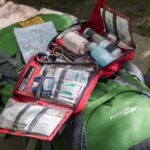Trail Essentials for Every Hiker
Whether you’re heading out for a short day hike or a six-month thru-hike, there are essentials that every hiker should carry on the Appalachian Trail (A.T.) to have a safe, low-impact journey.



In addition to planning ahead so that you know the terrain you expect to cover and how the Trail is marked, you will want to pack tools to know where you are!
- Always bring a map and a compass and have the knowledge to use them together.
- A GPS (with extra batteries) can be extremely useful for tracking your progress, in emergencies, and for showing where you are along the Trail.
- An updated guidebook should have descriptions of landmarks and waypoints to give you a better idea of what to expect on the Trail.
Visit our Navigation & Tools page for more info.
Even on hot, sunny, summer days, it is important to carry extra layers in case the weather takes a turn. Keep in mind, too, that you lose 5-10 degrees of warmth with every 1,000 feet you go up in elevation.
- Year-round, carry a long-sleeved shirt, wool/fleece-lined hat, and a rain jacket or poncho.
- Layers like a fleece sweater or jacket, long pants, and gloves are essential when you’re hiking anytime outside the height of summer.
Even on cold winter days, it’s important to stay hydrated!
- Make sure you can carry at least 2 liters of water, whether in bottles or a bladder.
- Even on day hikes, it’s a good idea to bring something to purify water in case you need to get more on the Trail. A water purification system like iodine, bleach, Aqua Mira, filters, or UV light are recommended since they neutralize/eliminate viruses, bacteria, and other naturally occurring entities that could be harmful to hikers.
Visit our water treatment page for more info on water purification.
Pack enough snacks to fuel your body for the exertion of your hike.
- Pack one extra snack for use in the event of an emergency that keeps you on Trail longer than expected.
- Make sure to carry a plastic bag to pack out anything you don’t consume, like apple cores, excess food, or food packaging.
See our Food & Cooking page for some snack ideas!
Carry a headlamp and extra batteries in case you stay out longer than intended.
The season and weather forecast will dictate what to bring.
- Sunglasses and sunscreen are important year-round, especially if you’ll be hiking through open fields or above treeline. A sun hat is helpful, too!
- Insect repellent can save your sanity on the Trail during the spring and summer.
ATC staff tip: Treat your clothing and gear with permethrin before you hit the Trail to protect yourself against ticks. You can also have your clothes treated through companies like InsectShield for longer-lasting protection.
Be prepared to answer nature’s call even on short day hikes.
- Bring toilet paper, a lightweight trowel, hand sanitizer*, and a resealable plastic bag.
- If you pee and use toilet paper (TP), pack it out in the plastic bag. Some folks opt to use a pee rag (a bandana or specially made cloth) to wipe pee so they don’t have to pack out used toilet paper.
- Poop in a privy if one is available. If one is not available, bury your poop and toilet paper in a hole 6’’ – 8’’ deep and at least 80 steps from the Trail and 80 steps from water sources.
Learn more about how to poop like a pro on the A.T.
*Note that hand sanitizer is not effective against some viruses, like norovirus. Use a small amount of biodegradable soap far from water sources.
- Adhesive bandages (e.g. Band-Aids) and moleskin can protect small cutes, scrapes, and blisters.
- Gauze and elastic bandage (e.g. Ace bandage) or sports tape can stabilize sprained ankles and deeper cuts.
- Anti-diarrheal, antihistamine, anti-inflammatory, and antibiotic cream are all helpful to carry in case you need them.
- Tweezers are great for removing embedded ticks and slivers.
- Don’t forget personal medications.
Learn more ideas on what to pack in your first aid kit.
Just a few small, lightweight items can help you be prepared for the unexpected.
- Duct tape, cord, and a few zip ties can be used to repair almost anything!
- A small knife is helpful for cutting these items (or for slicing cheese!)
- A sewing kit can fix ripped clothes or gear
- Extra batteries for your headlamp/flashlight
- A whistle in case you need to alert others to your location in an emergency
- A lighter or waterproof matches so you can build a fire in case you get lost and must spend the night outdoors
- Permanent marker to write clear notes
- Emergency water treatment tablets
Shoes that are comfortable and rated for hiking and the season can prevent hot spots, blisters, and greater foot injuries.
- In summer, many A.T. hikers wear lightweight trail runners that are breathable and dry quickly. In winter, you’ll likely want waterproof boots that are insulated.
- Whether you choose trail runners or boots, make sure your shoes are broken in. You should wear them walking, around the house, and on shorter hikes before using them on extended trips.
Backpacking and Overnight Hikes: The 10 Essentials
In addition to planning ahead so that you know the terrain you expect to cover and how the Trail is marked, you will want to pack tools to know where you are!
- Always bring a map and a compass and have the knowledge to use them together.
- A GPS (with extra batteries) can be extremely useful for tracking your progress, in emergencies, and for showing where you are along the Trail.
- An updated guidebook should have descriptions of landmarks and waypoints to give you a better idea of what to expect on the Trail. Many guidebooks designed for long-distance hikers will also have town info and list hiker services.
Visit our Navigation & Tools page for more info.
Even on hot, sunny, summer days, it is important to carry extra layers and the appropriate sleeping gear in case the weather takes a turn. Keep in mind, too, that you lose 5-10 degrees of warmth with every 1,000 feet you go up in elevation.
- Year-round, carry a long-sleeved shirt, wool/fleece-lined hat, and a rain jacket or poncho.
- Layers like a fleece sweater or jacket, long pants, and gloves are essential when you’re hiking anytime outside the height of summer.
- Carrying a sleeping pad will insulate you from the ground and generally improve a night’s sleep outdoors.
- Bring a sleeping bag rated for the season. Read more about how to choose a sleeping bag.
Even on winter trips, it’s important to stay hydrated!
- Make sure you can carry at least 2 liters of water, whether in bottles or a bladder.
- Water at A.T. shelters and campsites is not potable and must be purified before being used for cooking and cleaning. Visit our water page for more information about how to treat water on the Trail.
- Backpacking can burn over 6,000 calories per day. You need to properly fuel your body to have a safe and fun hike.
- Pack one extra snack and one extra dinner for use in the event of an emergency that keeps you on Trail longer than expected.
- Make sure to carry a plastic bag to pack out anything you don’t consume, like apple cores, excess food, or food packaging.
See our food and water pages for more info on what to eat and how much to carry on the A.T.
- In your “kitchen” be sure to include your camp stove, fuel, pot, utensil, and matches or a lighter.
- The ATC recommends backpackers use a bear canister as the most effective method for preventing bears and other critters from getting your food. Store all food, trash, and scented items (“smellables”) in your bear canister at night. If a food storage device is available where you’re camping (bear box, cables, or pole), please use it.
Learn more about food storage and bear safety on the Trail.
While three-sided shelters or lean-tos are located at varying intervals along the A.T. and offer a great overnight place to stop, use of them is on a first-come, first-served basis, thus not guaranteed. Backpackers on the A.T. should always carry a tent, tarp, bivy, or hammock.
Carry a headlamp and extra batteries.
The season and weather forecast will dictate what to bring.
- Sunglasses and sunscreen are important year-round, especially if you’ll be hiking through open fields or above treeline. A sun hat is helpful, too!
- Insect repellent can save your sanity on the Trail during the spring and summer.
ATC staff tip: Treat your clothing and gear with permethrin before you hit the Trail to protect yourself against ticks. You can also have your clothes treated through companies like InsectShield for longer-lasting protection.
A note for thru-hikers: The ATC recommends that northbound thru-hikers keep their cold weather gear until they are north of the Grayson Highlands in Virginia and get it back before going through the White Mountains of New Hampshire. Southbounders should do the opposite: keep their warm weather gear until they are south of the White Mountains and get it back before the Grayson Highlands.
Be prepared to answer nature’s call on the Trail.
- Bring toilet paper, a lightweight trowel, hand sanitizer*, and a resealable plastic bag.
- If you pee and use toilet paper (TP), pack it out in the plastic bag. Some folks opt to use a pee rag (a bandana or specially made cloth) to wipe pee so they don’t have to pack out used toilet paper.
- Poop in a privy if one is available. If one is not available, bury your poop and toilet paper in a hole 6’’ – 8’’ deep and at least 80 steps from the Trail and 80 steps from water sources.
Learn more about how to poop like a pro on the A.T.
*Note that hand sanitizer is not effective against some viruses, like norovirus. Use a small amount of biodegradable soap far from water sources.
- Adhesive bandages (e.g. Band-Aids) and moleskin can protect small cutes, scrapes, and blisters.
- Gauze and elastic bandage (e.g. Ace bandage) or sports tape can stabilize sprained ankles and deeper cuts.
- Anti-diarrheal, antihistamine, anti-inflammatory, and antibiotic cream are all helpful to carry in case you need them.
- Tweezers are great for removing embedded ticks and slivers.
- Don’t forget personal medications.
Learn more ideas on what to pack in your first aid kit.
Just a few small, lightweight items can help you be prepared for the unexpected.
- Duct tape, cord, and a few zip ties can be used to repair almost anything!
- A small knife is helpful for cutting these items (or for slicing cheese!)
- A sewing kit can fix ripped clothes or gear
- Extra batteries for your headlamp/flashlight
- A whistle in case you need to alert others to your location in an emergency
- A lighter or waterproof matches so you can build a fire in case you get lost and must spend the night outdoors
- Permanent marker to write clear notes
- Emergency water treatment tablets
- Pack cover or a contractor garbage bag as a pack liner
- Footprint (if using a tent)
- Watch
- Trekking Poles
- Backup water treatment
- Knowledge of:
- Location regulations
- Weather forecast
- Terrain and distance of your chosen hike with bail-out points for emergencies


